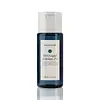What's inside
What's inside
 Key Ingredients
Key Ingredients

 Benefits
Benefits

 Concerns
Concerns

 Ingredients Side-by-side
Ingredients Side-by-side

Water
Skin ConditioningButylene Glycol
HumectantPropanediol
SolventSalicylic Acid
MaskingSodium Polyacrylate
AbsorbentCitric Acid
BufferingGlycerin
HumectantDiglycerin
HumectantCitrus Glauca Fruit Extract
HumectantMicrocitrus Australasica Fruit Extract
Microcitrus Australis Fruit Extract
Skin ConditioningHydroxyacetophenone
AntioxidantCarrageenan
Phenoxyethanol
PreservativeSodium Phytate
Caprylyl Glycol
EmollientPhenylpropanol
MaskingTocopherol
AntioxidantWater, Butylene Glycol, Propanediol, Salicylic Acid, Sodium Polyacrylate, Citric Acid, Glycerin, Diglycerin, Citrus Glauca Fruit Extract, Microcitrus Australasica Fruit Extract, Microcitrus Australis Fruit Extract, Hydroxyacetophenone, Carrageenan, Phenoxyethanol, Sodium Phytate, Caprylyl Glycol, Phenylpropanol, Tocopherol
Water
Skin ConditioningTalc
AbrasiveDimethicone
EmollientDicaprylyl Ether
EmollientCetyl PEG/PPG-10/1 Dimethicone
EmulsifyingGlycerin
HumectantIsododecane
EmollientTrimethylsiloxysilicate
EmollientSodium Hyaluronate
HumectantTocopherol
AntioxidantHydrogen Dimethicone
Sodium Chloride
MaskingMagnesium Sulfate
Polysilicone-11
Disteardimonium Hectorite
StabilisingStevia Rebaudiana Extract
Propylene Carbonate
SolventEthylhexylglycerin
Skin ConditioningLaureth-12
EmulsifyingAluminum Hydroxide
EmollientPhenoxyethanol
PreservativeSodium Dehydroacetate
PreservativePotassium Sorbate
PreservativeBenzoic Acid
MaskingDehydroacetic Acid
PreservativeSorbic Acid
PreservativeParfum
MaskingCI 77491
Cosmetic ColorantCI 77492
Cosmetic ColorantCI 77499
Cosmetic ColorantCI 77891
Cosmetic ColorantWater, Talc, Dimethicone, Dicaprylyl Ether, Cetyl PEG/PPG-10/1 Dimethicone, Glycerin, Isododecane, Trimethylsiloxysilicate, Sodium Hyaluronate, Tocopherol, Hydrogen Dimethicone, Sodium Chloride, Magnesium Sulfate, Polysilicone-11, Disteardimonium Hectorite, Stevia Rebaudiana Extract, Propylene Carbonate, Ethylhexylglycerin, Laureth-12, Aluminum Hydroxide, Phenoxyethanol, Sodium Dehydroacetate, Potassium Sorbate, Benzoic Acid, Dehydroacetic Acid, Sorbic Acid, Parfum, CI 77491, CI 77492, CI 77499, CI 77891
 Reviews
Reviews

Ingredients Explained
These ingredients are found in both products.
Ingredients higher up in an ingredient list are typically present in a larger amount.
Glycerin is already naturally found in your skin. It helps moisturize and protect your skin.
A study from 2016 found glycerin to be more effective as a humectant than AHAs and hyaluronic acid.
As a humectant, it helps the skin stay hydrated by pulling moisture to your skin. The low molecular weight of glycerin allows it to pull moisture into the deeper layers of your skin.
Hydrated skin improves your skin barrier; Your skin barrier helps protect against irritants and bacteria.
Glycerin has also been found to have antimicrobial and antiviral properties. Due to these properties, glycerin is often used in wound and burn treatments.
In cosmetics, glycerin is usually derived from plants such as soybean or palm. However, it can also be sourced from animals, such as tallow or animal fat.
This ingredient is organic, colorless, odorless, and non-toxic.
Glycerin is the name for this ingredient in American English. British English uses Glycerol/Glycerine.
Learn more about GlycerinPhenoxyethanol is a preservative that has germicide, antimicrobial, and aromatic properties. Studies show that phenoxyethanol can prevent microbial growth. By itself, it has a scent that is similar to that of a rose.
It's often used in formulations along with Caprylyl Glycol to preserve the shelf life of products.
Tocopherol (also known as Vitamin E) is a common antioxidant used to help protect the skin from free-radicals and strengthen the skin barrier. It's also fat soluble - this means our skin is great at absorbing it.
Vitamin E also helps keep your natural skin lipids healthy. Your lipid skin barrier naturally consists of lipids, ceramides, and fatty acids. Vitamin E offers extra protection for your skin’s lipid barrier, keeping your skin healthy and nourished.
Another benefit is a bit of UV protection. Vitamin E helps reduce the damage caused by UVB rays. (It should not replace your sunscreen). Combining it with Vitamin C can decrease sunburned cells and hyperpigmentation after UV exposure.
You might have noticed Vitamin E + C often paired together. This is because it is great at stabilizing Vitamin C. Using the two together helps increase the effectiveness of both ingredients.
There are often claims that Vitamin E can reduce/prevent scarring, but these claims haven't been confirmed by scientific research.
Learn more about TocopherolWater. It's the most common cosmetic ingredient of all. You'll usually see it at the top of ingredient lists, meaning that it makes up the largest part of the product.
So why is it so popular? Water most often acts as a solvent - this means that it helps dissolve other ingredients into the formulation.
You'll also recognize water as that liquid we all need to stay alive. If you see this, drink a glass of water. Stay hydrated!
Learn more about Water